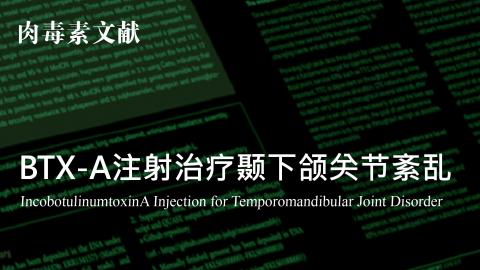
- 3470人
- 分享收藏
【肉毒素文献】BTX-A注射治疗颞下颌关节紊乱
IncobotulinumtoxinA Injection for
简介
【 文献重点摘要 】
Objectives: Temporomandibular Disorder (TMD) involves dysfunction of the temporomandibular joint and associated muscles of mastication causing pain with chewing, limitation of jaw movement, and chronic orofacial pain. While the exact pathophysiology of TMD is not completely understood, it is thought that hyperfunction of the muscles of mastication place undue stress on the temporomandibular joint, which leads to degeneration of the joint and associated symptoms. We hypothesize that chemodenervation of the muscles of mastication with Xeomin (Incobotulinumtoxina) will decrease the stress on the temporomandibular joint and thus improve pain associated with TMJD.
Methods: 20 patients were randomized to either Xeomin (170 units) or saline injection of the masseters and pterygoid muscles. Patient reported pain scale (0-10) was recorded at 4-week intervals following injection for 16 weeks. Patients who received saline injection initially were assessed for reduction in pain at the first four week interval and if still had significant pain, were rolled over into the Xeomin arm.
Results: Results were available for 19/20 patients. Preinjection average pain scores were similar between patients. While there was a statistically significant reduction in pain score in the placebo group after one month, there was an overall larger drop in average pain scores in those patients injected with Xeomin initially. All patients injected with placebo initially crossed over into the Xeomin group. Similar results were seen when examining the composite masticatory muscle tenderness scores. There was no significant change in usage of pain medication.
Conclusions: We demonstrate utility of Xeomin (incobotulinumtoxinA) in treating patients with TMD with persistent pain despite pain medication usage and other conventional treatments.
目的:颞下颌关节紊乱病(TMD)涉及颞下颌关节及相关咀嚼肌功能障碍、咀嚼痛、下颌运动受限和慢性口面部疼痛。虽然TMD的确切病理生理机制尚不完全清楚,但人们认为咀嚼肌功能亢进对颞下颌关节施加了过大的压力,从而导致关节退变及相关症状。我们假设,用Xeomin(Incobotulinumtoxina)对咀嚼肌进行化学去神经支配可以减少颞下颌关节的应力,从而改善与TMJD相关的疼痛。
方法:20例患者被随机分为Xeomin(170单位)或生理盐水注射咀嚼肌和翼状肌。患者报告疼痛评分(0-10)在注射16周后每隔4周记录一次。最初接受生理盐水注射的患者在前四周的间隔时间内被评估为疼痛减轻,如果仍然有明显的疼痛,则滚入Xeomin手臂。
结果:20例患者中有19例获得结果。患者之间注射前的平均疼痛评分相似。虽然安慰剂组在一个月后疼痛评分有统计上的显著下降,但在那些最初注射Xeomin的患者中,总体上平均疼痛评分的下降幅度更大。所有注射安慰剂的患者最初都进入Xeomin组。在检查复合咀嚼肌肉压痛分数时,也看到了类似的结果。止痛药的使用没有明显变化。
结论:我们证明了Xeomin(IncobotulinumtoxinA)在治疗持续疼痛的TMD患者中的有效性,尽管使用了止痛药和其他常规治疗。



